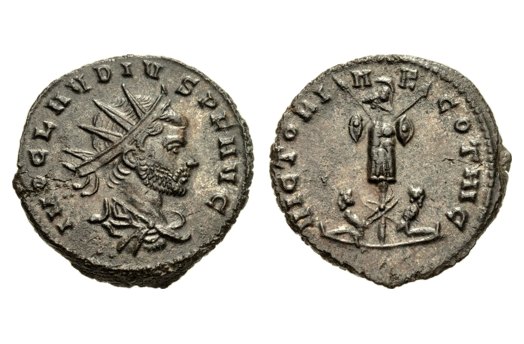
about ancient nomos
Ancient Nomos Art is a museum of galleries exhibiting ancient coins and ancient mint maps. The coin gallery displays the diverse art and history of hand-crafted ancient Greek, Roman, Byzantine, Persian and Medieval coinage. The ancient mints mapping gallery features Greek, Roman, Byzantine, Asia Minor and Medieval mint city regions and territories. Visitor's are welcome to explore, study and enjoy Ancient Nomos Art.

Imperial, Roman – 269 AD
Claudius II
From Ancient Galleries

Obverse: Radiate, draped and cuirassed bust of Claudius II Gothicus, two pellets below.
Reverse: Legend: VICTORIAE GOTHIC, with military trophy of captured arms and bound captives.
LEGEND
Obv: IMP CLAVDIVS P F AVG, Radiate, draped and cuirassed bust of a bearded Claudius II Gothicus, facing to the right; two small pellets below shoulders. Rev: VICTORI-A-E GOTHIC, Military trophy of captured arms mounted on a post with two captives seated on the exergue plane (ground line), with arms bound to the post.
Claudius II (Marcus Aurelius Valerius Claudius Augustus), commonly known as Claudius Gothicus, was Roman Emperor from 268 to 270. Claudius II was born in Illyricum around 215 A.D. Under Valerian and Gallienus he was recognized as a superb and capable general. Following the murder of Gallienus, Claudius Gothicus was proclaimed emperor. One of his first duties was to campaign against the Alemani tribe in the north, who had earlier invaded the southern Italia regions, with enormous garrisons of Goths pouring into the empire. Against Rome’s advice, Claudius confronted the barbarians at Naissus in Upper Moesia and with his cavalry commander, future Emperor Aurelian, was able to destroy the Gothic cavalry by storming their laager (a circular alignment of wagons long favored by the Goths). The victory earned Claudius his surname of “Gothicus” (conqueror of the Goths), a name that continues on even to this day. Perhaps more important is the fact that the Goths were driven back across the Danube River by Claudius II, with a full century passing before they again posed a serious threat to the empire. The above Claudius II coin is a scarce and historically significant Roman imperial issue. The beautifully detailed obverse bust of Claudius II skillfully depicts the bearded emperor fully draped in his imperial garments as commander of the legions, and wearing his radiate crown. The numismatic importance of the reverse legend is twofold. First, the reverse legend and imagery documents and commemorates the great victory Claudius II achieved over the Goths at Naissus in Upper Moesia. Second, the legend is the first time the word GOTHIC appears on a coin. Unfortunately, after a reign of only two short years, Claudius II died after succumbing to a plague (perhaps smallpox) that had been ravaging the Roman provinces at the time.
DOCUMENTATION
Value: Antoninianus. Metal: AR Silver. Weight: 3.71 grams. Mint: Cyzicus. Date: 269 AD, 3rd emission. Attribution: Roman Imperial Coinage 252 (variety); Cohen 308 (variety); also RIC Online 977. Photo courtesy Nomos AG.
Legend, Documentation and Attribution
